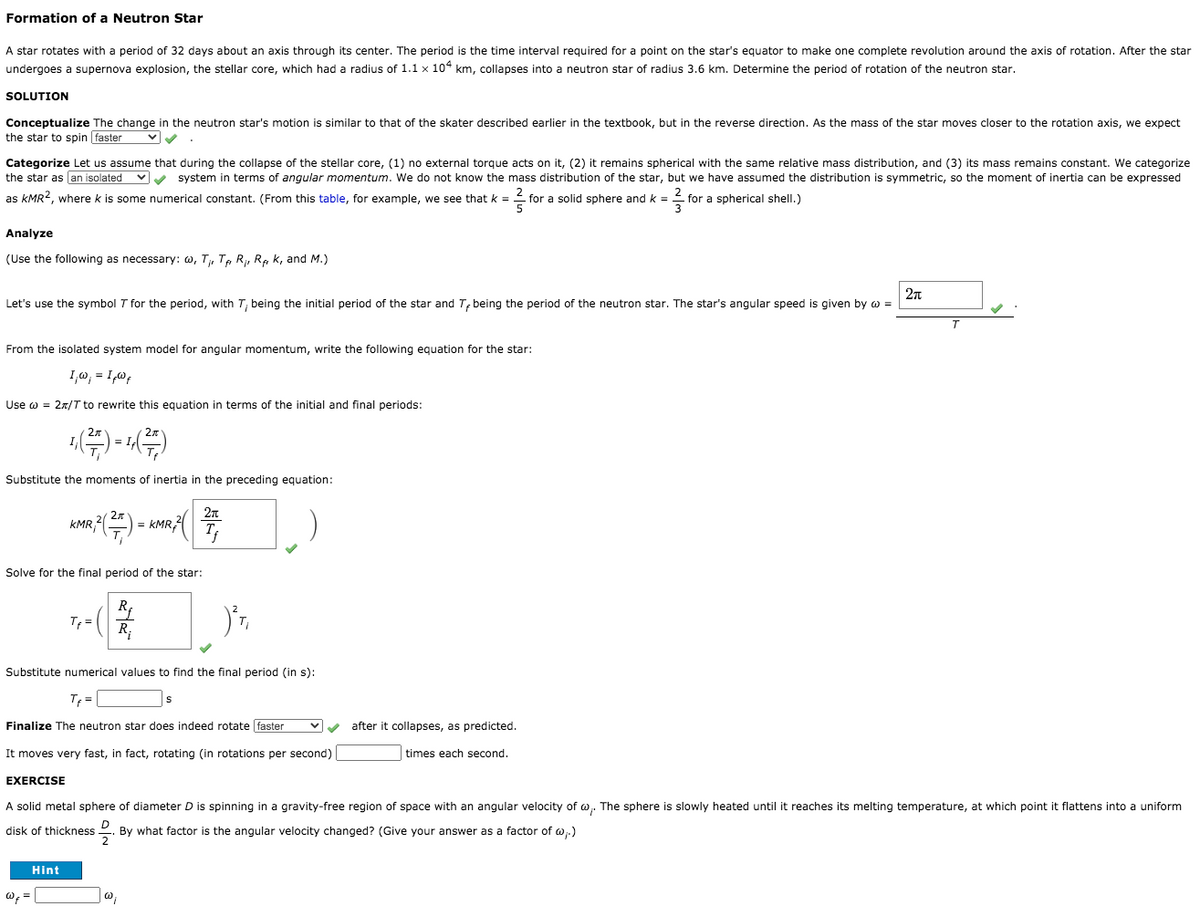EXERCISE A solid metal sphere of diameter D is spinning in a gravity-free region of space with an angular velocity of w. The sphere is slowly heated until it reaches its melting temperature, at which point it flattens into a uniform disk of thickness 2. By what factor is the angular velocity changed? (Give your answer as a factor of w.) Hint
EXERCISE A solid metal sphere of diameter D is spinning in a gravity-free region of space with an angular velocity of w. The sphere is slowly heated until it reaches its melting temperature, at which point it flattens into a uniform disk of thickness 2. By what factor is the angular velocity changed? (Give your answer as a factor of w.) Hint
Physics for Scientists and Engineers: Foundations and Connections
1st Edition
ISBN:9781133939146
Author:Katz, Debora M.
Publisher:Katz, Debora M.
Chapter12: Rotation I: Kinematics And Dynamics
Section: Chapter Questions
Problem 15PQ
Related questions
Question

Transcribed Image Text:Formation of a Neutron Star
A star rotates with a period of 32 days about an axis through its center. The period is the time interval required for a point on the star's equator to make one complete revolution around the axis of rotation. After the star
undergoes a supernova explosion, the stellar core, which had
radius of 1.1 x 104 km, collapses into a neutron star of radius 3.6 km. Determine the period of rotation of the neutron star.
SOLUTION
Conceptualize The change in the neutron star's motion is similar to that of the skater described earlier in the textbook, but in the reverse direction. As the mass of the star moves closer to the rotation axis, we expect
the star to spin faster
Categorize Let us assume that during the collapse of the stellar core, (1) no external torque acts on it, (2) it remains spherical with the same relative mass distribution, and (3) its mass remains constant. We categorize
system in terms of angular momentum. We do not know the mass distribution of the star, but we have assumed the distribution is symmetric, so the moment of inertia can be expressed
the star as an isolated
as KMR2, where k is some numerical constant. (From this table, for example, we see that k =
for a solid sphere and k =
for a spherical shell.)
Analyze
(Use the following as necessary: w, T, Tp R, Rp, k, and M.)
Let's use the symbol T for the period, with T, being the initial period of the star and T, being the period of the neutron star. The star's angular speed is given by w =
T.
From the isolated system model for angular momentum, write the following equation for the star:
oI = 'm'I
Use w = 27/T to rewrite this equation in terms of the initial and final periods:
Substitute the moments of inertia in the preceding equation:
kMR,
kMR,
Solve for the final period of the star:
Tf =
R;
Substitute numerical values to find the final period (in s):
Tf =
Finalize The neutron star does indeed rotate faster
after it collapses, as predicted.
It moves very fast, in fact, rotating (in rotations per second)
times each second.
EXERCISE
A solid metal sphere of diameter D is spinning in a gravity-free region of space with an angular velocity of w. The sphere is slowly heated until it reaches its melting temperature, at which point it flattens into a uniform
disk of thickness 2. By what factor is the angular velocity changed? (Give your answer as a factor of w,.)
Hint
Expert Solution
This question has been solved!
Explore an expertly crafted, step-by-step solution for a thorough understanding of key concepts.
This is a popular solution!
Trending now
This is a popular solution!
Step by step
Solved in 4 steps with 5 images

Knowledge Booster
Learn more about
Need a deep-dive on the concept behind this application? Look no further. Learn more about this topic, physics and related others by exploring similar questions and additional content below.Recommended textbooks for you

Physics for Scientists and Engineers: Foundations…
Physics
ISBN:
9781133939146
Author:
Katz, Debora M.
Publisher:
Cengage Learning

Physics for Scientists and Engineers, Technology …
Physics
ISBN:
9781305116399
Author:
Raymond A. Serway, John W. Jewett
Publisher:
Cengage Learning

Glencoe Physics: Principles and Problems, Student…
Physics
ISBN:
9780078807213
Author:
Paul W. Zitzewitz
Publisher:
Glencoe/McGraw-Hill

Physics for Scientists and Engineers: Foundations…
Physics
ISBN:
9781133939146
Author:
Katz, Debora M.
Publisher:
Cengage Learning

Physics for Scientists and Engineers, Technology …
Physics
ISBN:
9781305116399
Author:
Raymond A. Serway, John W. Jewett
Publisher:
Cengage Learning

Glencoe Physics: Principles and Problems, Student…
Physics
ISBN:
9780078807213
Author:
Paul W. Zitzewitz
Publisher:
Glencoe/McGraw-Hill

University Physics Volume 1
Physics
ISBN:
9781938168277
Author:
William Moebs, Samuel J. Ling, Jeff Sanny
Publisher:
OpenStax - Rice University

Principles of Physics: A Calculus-Based Text
Physics
ISBN:
9781133104261
Author:
Raymond A. Serway, John W. Jewett
Publisher:
Cengage Learning

Classical Dynamics of Particles and Systems
Physics
ISBN:
9780534408961
Author:
Stephen T. Thornton, Jerry B. Marion
Publisher:
Cengage Learning